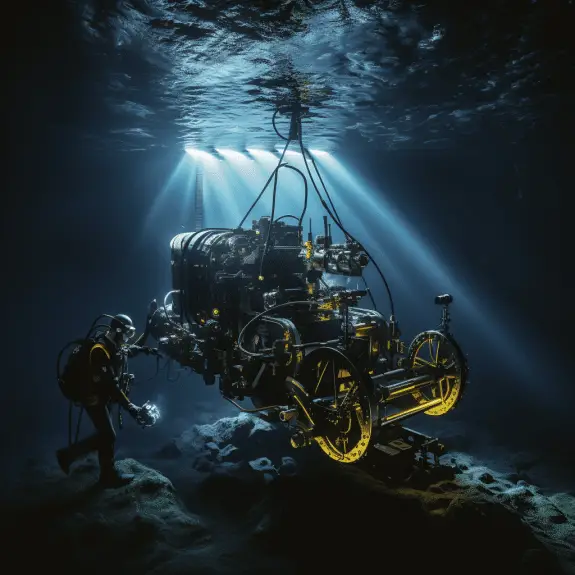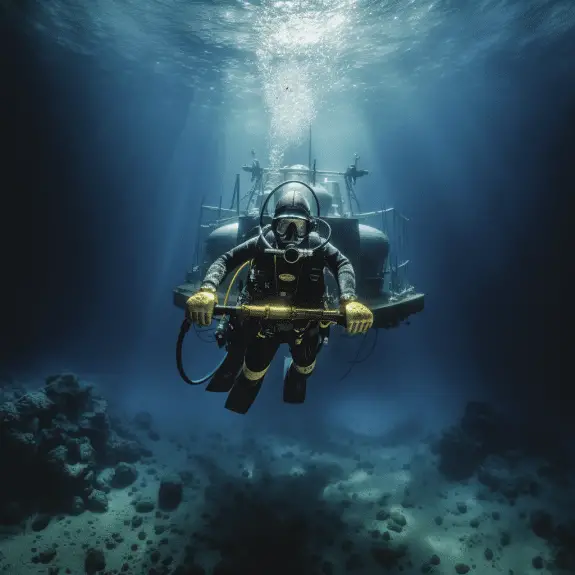As a professional copywriting journalist, I am often drawn to the fascinating world of deep-sea diving and underwater exploration. One technique that has piqued my interest is saturation diving, which enables divers to work at significant depths for extended periods. In this section, we’ll explore what saturation diving is, its applications in offshore exploration, and how it plays a crucial role in enabling human advancements in underwater environments.
Key takeaways:
- Saturation diving is a specialized technique that allows divers to work at significant depths for extended periods.
- It finds diverse applications in various industries, including offshore exploration and infrastructure repairs.
- Saturation diving enables human advancements in underwater environments and plays a crucial role in deep-sea exploration.

The Science Behind Saturation Diving
Saturation diving is when divers live in a pressurized environment for days or weeks. This technique allows them to work at great depths for a long time. The physics behind saturation diving is complicated. Divers need to decompress after a high-pressure dive to stay safe. Decompression involves gradually reducing the pressure surrounding the diver, allowing their body to adjust to the changes in pressure slowly.
Divers use a hyperbaric chamber to help them decompress. These chambers imitate the underwater conditions and help divers decompress safely. The air pressure in the chamber is slowly reduced, allowing the diver to adjust to the changes gradually.
The Importance of Diver Safety
Diver safety is of utmost importance in saturation divings.
Saturation diving is dangerous without safety measures. Safety measures include training, proper equipment, and safety protocols. Divers’ health is monitored through check-ups to prevent harm from high-pressure.
Applications of Saturation Diving
Saturation diving has found a diverse range of applications in various industries, including underwater welding and commercial diving.
Underwater welding involves repairing infrastructure beneath the ocean’s surface, such as pipelines and offshore drilling platforms. Saturation diving provides a controlled environment that enables welders to work at significant depths for extended periods without the need for repeated decompressions. This method enhances productivity, reduces risks, and enables the repair of vital infrastructure to ensure continued operation.
| Benefits of Underwater Welding with Saturation Diving | Challenges of Underwater Welding without Saturation Diving |
|---|---|
| Allows for repairs to be carried out at significant depths | Requires multiple decompressions, reducing productivity |
| Reduces the risk of nitrogen narcosis and decompression sickness | Increases the risk of nitrogen narcosis and decompression sickness |
| Enables welders to work for extended periods, increasing productivity and reducing costs | Limits the amount of time that welders can work, reducing productivity and increasing costs |
Commercial diving
Operations also rely on saturation diving to execute tasks such as underwater inspections, construction, and maintenance in offshore environments. Saturation diving allows for long-duration dives while maintaining diver safety and reducing the need for decompression. This method improves productivity, reduces risks, and enhances the effectiveness of commercial diving operations.
- Underwater inspections: Saturation divings enables divers to inspect underwater structures, such as pipelines, bridges, and dams, for damage, corrosion, or other potential issues. This approach is critical for the maintenance of vital infrastructure and the protection of public safety.
- Construction: Saturation divings is used in underwater construction projects to build and install structures such as oil rigs, wind turbines, and underwater pipelines. This method ensures that construction workers can work for extended periods without the need for frequent decompressions, reducing downtime and improving productivity.
- Maintenance: Saturation diving is also utilized for routine maintenance of offshore structures, such as cleaning and repair work. This method enables workers to carry out tasks more efficiently and safely, reducing the risks of accidents and injuries.
In conclusion, saturation divings plays a critical role in enabling various industries to carry out essential tasks in deep-sea environments. It provides a safe and controlled environment for divers to work for extended periods and enhances productivity while reducing risks. Whether it’s repairing vital infrastructure or executing commercial diving operations, saturation diving is a crucial tool for underwater exploration and human advancement.

Conclusion
As a professional copywriting journalist, I have had the privilege of exploring the intricacies of saturation divings.
Saturation diving is important for deep-sea exploration and human advancements in underwater environments. Understanding the science and diver safety is key to appreciating its achievements. Hyperbaric chambers are used for decompression and safety measures protect divers during high-pressure dives.
The Importance of Saturation Diving
Saturation divings finds diverse applications in various industries, including underwater welding, a vital component of infrastructure repairs beneath the ocean’s surface. Additionally, commercial divings operations rely on saturation divings to execute tasks such as underwater inspections, construction, and maintenance in offshore environments.
As we continue to push the boundaries of underwater exploration, it is clear that saturation divings will remain a critical component of these endeavors. With ongoing advancements in technology and safety measures, saturation diving will continue to unlock new possibilities for human exploration beneath the ocean’s surface.
FAQ
What is saturation divings?
Saturation diving is a specialized diving technique that allows divers to work at significant depths for extended periods. It involves the use of hyperbaric chambers for diver decompression and maintaining proper pressure levels.
What are the applications of saturation divings?
Saturation divings has diverse applications, including underwater welding for infrastructure repairs and commercial diving operations for underwater inspections, construction, and maintenance in offshore environments.
How does saturation divings ensure diver safety?
Saturation divings employs comprehensive safety measures, such as high-pressure divers’ decompression in hyperbaric chambers, to protect divers during their dives at great depths.
What is the significance of saturation divings in deep-sea exploration?
Saturation divings plays a crucial role in enabling deep-sea exploration and provides a platform for human advancements in underwater environments.
